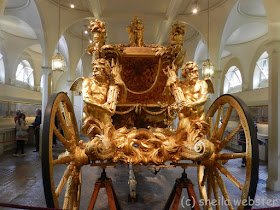We planned our day in London around a visit to Buckingham Palace. This was a 'must see' on our trip and I was looking forward to seeing the Queen's home in all its' splendor. Our tickets were purchased online ahead of time, which is a very easy thing to do and likely saved us time when we arrived as we didn't have to stand in line. Part of the ticket entrance included visiting the Royal Mews, where the carriages and horses are kept and we chose to visit here first.
There are several carriages displayed in individual rooms with some of their history and stories told on a story board as well as more information given on our hand held guide that gave us lots of information. They were all very grand and pretty exciting to see in their amazing condition, some of which had had extensive rebuilding done to be as they originally appeared. We also walked through the stables and saw some of the horses but the one coach we saw that was absolutely amazing was the Gold State Coach.
King George III had this coach designed by architect Sir William Chambers in 1760 for his coronation and wedding to Princess Charlotte. It wasn't ready in time for either celebration so it made its' debut in 1762 being pulled by eight cream stallions, when King George attended the State Opening of Parliament. The coach weighs 4 ton and needed those eight horses to pull that weight. The coach is 24 ft. long, 8 ft. wide and 12 ft. high. The cost in English currency was 8,000 pounds when it was built.
Incredible artistry of the sculpture Joseph Wilton is shown on this coach. The details are amazing when you're able to see all that this coach is adorned with. The mythical sea-gods at the front of the coach, known as Tritons seem to be pulling it with straps as they blow on their conches to announce the arrival of the Monarch of the Ocean.
The eight panels, three on each side and one on each end were painted by Giovanni Battista Cipriani. Each panel represents the pride the English took in their military achievements, their wealth and success and all that made it the great country that it was. I find it interesting that Greek and Roman symbols were used by this Italian artist on an English coach but they are amazing paintings. Cipriani, a neoclassical painter, was brought to England in 1755 by Sir William Chambers and Joseph Wilton several years before the coach was to become their project.
The mythical sea-gods with the body of man and legs and feet of a dolphin on the back of the coach are representing England's imperial powers, together with the ones on the front. They represent Britain's strong maritime traditions and show England's dominant seapower. These carvings reflect the powerful position that England held in the world.
At the back of the coach, this Triton carries a bundle of rods with an axe and that represented the power of the law. Everything on the coach had a special meaning and told the story of what was thought of England in that time. They were a powerful nation in their worldly position and this was representing their triumphant chariot.
The three cherubs at the top of the coach represent the union of England, Scotland and Ireland. They carry the symbols to represent Knighthood, a sword, sceptre and a badge as well as the Imperial Crown. Their gifts symbolize abundance and prosperity to the gods.
This coach was absolutely amazing to see and learn about. The history lesson of this day was one not to be forgotten.






